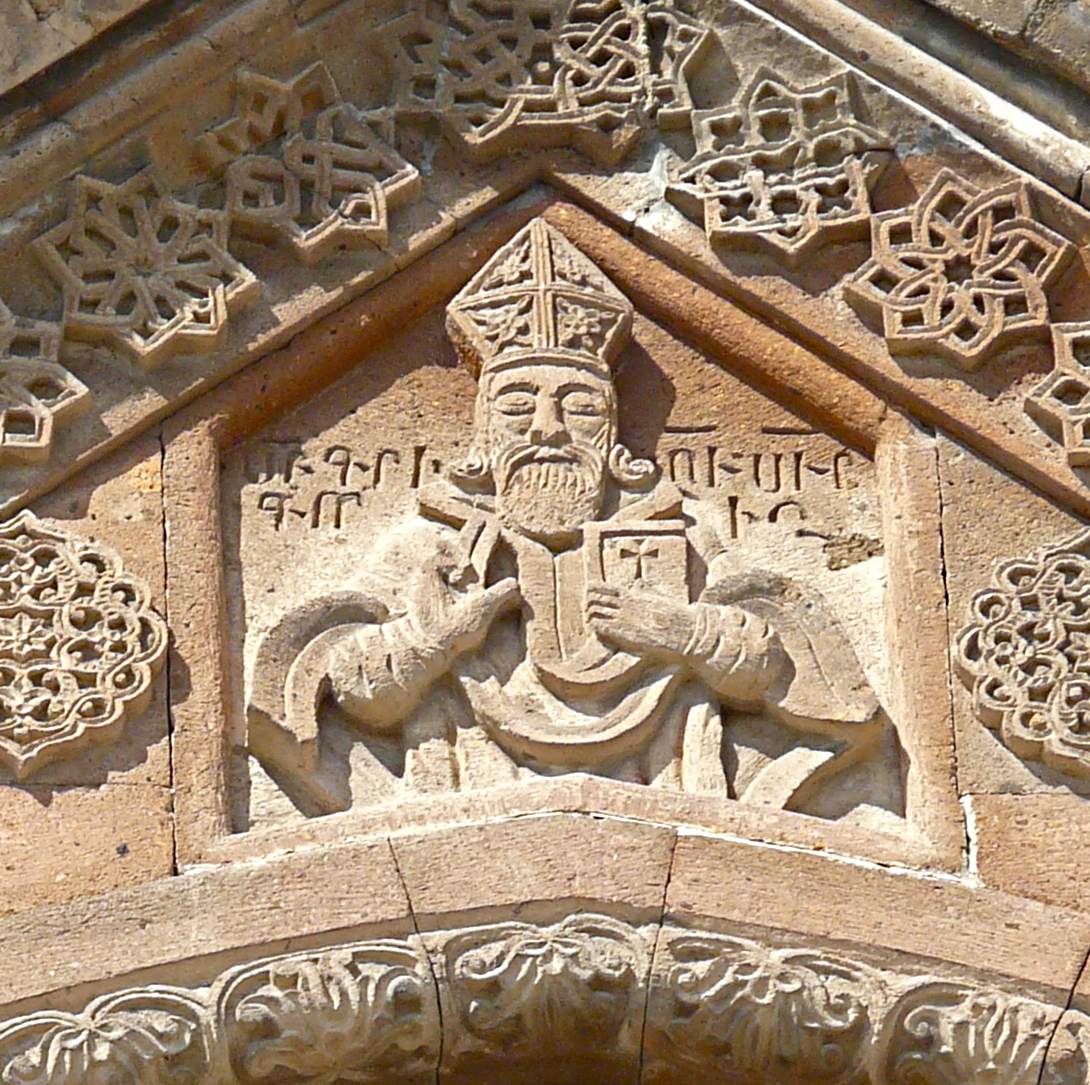Return
|
Ref ID: 1AR2016/297 | Posted On: 21-07-2016 | Updated on: 17-07-2024
|
|
Etchmiadzin Cathedral
Etchmiadzin Cathedral[C] (Armenian: Էջմիածնի Մայր տաճար, Ēǰmiatsni Mayr tačar) is the mother church of the Armenian Apostolic Church, located in the city of Vagharshapat (Etchmiadzin), Armenia.[D] According to scholars it was the first cathedral built in ancient Armenia,[E] and is considered the oldest cathedral in the world.[F]
The original church was built in the early fourth century[33]—between 301 and 303 according to tradition—by Armenia's patron saint Gregory the Illuminator, following the adoption of Christianity as a state religion by King Tiridates III. It replaced a preexisting temple, symbolizing the conversion from paganism to Christianity. The core of the current building was built in 483/4 by Vahan Mamikonian after the cathedral was severely damaged in a Persian invasion. From its foundation until the second half of the fifth century, Etchmiadzin was the seat of the Catholicos, the supreme head of the Armenian Church.
Although never losing its significance, the cathedral subsequently suffered centuries of virtual neglect. In 1441 it was restored as catholicosate and remains as such to this day.[34] Since then the Mother See of Holy Etchmiadzin has been the administrative headquarters of the Armenian Church. Etchmiadzin was plundered by Shah Abbas I of Persia in 1604, when relics and stones were taken out of the cathedral in an effort to undermine Armenians' attachment to their land. Since then the cathedral has undergone a number of renovations. Belfries were added in the latter half of the seventeenth century and in 1868 a sacristy was constructed at the cathedral's east end.[2] Today, it incorporates styles of different periods of Armenian architecture. Diminished during the early Soviet period, Etchmiadzin revived again in the second half of the twentieth century, and under independent Armenia.[2]
As the main shrine of religious Christian Armenians worldwide, Etchmiadzin has been an important location in Armenia not only religiously, but also politically and culturally.[35] A major pilgrimage site, it is one of the most visited places in the country.[36] Along with several important early medieval churches located nearby, the cathedral was listed as a World Heritage Site by UNESCO in 2000.
| Etchmiadzin Cathedral | |
|---|---|
 View of the cathedral from the south-east, 2010 View of the cathedral from the south-east, 2010 |
|
| Basic information | |
| Location | Vagharshapat, Armavir Province, Armenia |
| Geographic coordinates | 40.161769°N 44.291164°ECoordinates: 40.161769°N 44.291164°E |
| Affiliation | Armenian Apostolic Church |
| Rite | Armenian |
| Country | Armenia |
| Status | Active |
| Leadership | Catholicos of All Armenians |
| Architectural description | |
| Architectural type | Cathedral |
| Architectural style | Armenian |
| Founder | Gregory the Illuminator (original) |
| Groundbreaking | 301 (original building; traditional date)[1] |
| Completed | 303 (original building; traditional date)[1] 483/4–1868 (current building)[show] |
| Specifications | |
| Length | 33 metres (108 ft)[2] |
| Width | 30 metres (98 ft)[2] |
| Height (max) | not available; over 27 metres (89 ft)[B] |
| UNESCO World Heritage Site | |
History

A relief of Gregory the Illuminator on the cathedral's western belfry (1650s)
Foundation and etymology
According to tradition, the cathedral was built between 301 and 303[4][G] near the royal palace in then Armenian capital city of Vagharshapat,[1] on the location of a pagan temple.[H] The Kingdom of Armenia under Tiridates III became the first country in the world to adopt Christianity as a state religion in 301.[I] According to History of the Armenians (c. 460) by Agathangelos, Armenia's patron saint Gregory the Illuminator had a vision of Jesus Christ descending from heaven and striking the earth with a golden hammer to show where the cathedral should be built. Hence, the patriarch gave the church the name of Etchmiadzin (էջ ēĵ "descent" + մի mi "only" + -ա- -a- (linking element) + ծին tsin "begotten"),[48] which translates to "the Descent of the Only-Begotten [Son of God]."[2][19] However, the name Etchmiadzin did not come into use until the 15th century,[4] while earlier sources call it "Cathedral of Vagharshapat" (Վաղարշապատի Կաթողիկե եկեղեցի Vağaršapati Kat'oğike ekeghetsi)[49][50] or simply Kat'oghike (Կաթողիկե, literally "Cathedral").[38][J] The Feast of the Cathedral of Holy Etchmiadzin (Տոն Կաթողիկե Սբ. Էջմիածնի) is celebrated by the Armenian Church 64 days after Easter, during which "a special hymn is sung, written by the 8th century Catholicos Sahak III of Dzorapor, telling of St. Gregory's vision and the Cathedral's construction."[51]
as proposed by Alexander Sahinian (1966)[52] |
|
 |
 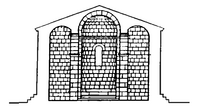 |
During archaeological excavations at the cathedral in 1955–56 and 1959, led by architectural historian Alexander Sahinian, remains of the original 4th-century building were discovered—including two levels of pillar bases below the current ones and a narrower altar apse under the present one.[1][38] Based on these findings, Sahinian asserted that the original church had been a three-naved[53] vaulted basilica,[1] similar to the basilicas of Tekor, Ashtarak and Aparan (Kasakh).[54] However, other scholars, have rejected Sahinian's view. Among them, Suren Yeremian and Armen Khatchatrian held that the original church had been in the form of a rectangle with a dome supported by four pillars.[53] Stepan Mnatsakanian suggested that the original building had been a "canopy erected on a cross [plan]," while architecture researcher Vahagn Grigoryan suggests an "extreme view,"[55] according to which the cathedral has been essentially in the same form as it is today.[53]
Reconstruction and decline

The ground plan of the cathedral after the 5th century reconstruction
According to Faustus of Byzantium, the cathedral and the city of Vagharshapat were almost completely destroyed during the invasion of Persian King Shapur II in the 360s[56] (circa 363).[2][57] Due to Armenia's bad economic conditions, the cathedral was renovated by Catholicoi Nerses the Great (r. 353–373) and Sahak Parthev (r. 387–439) only urgently and partially.[33]
In 387, Armenia was partitioned between the Roman Empire and the Sasanian Empire. The eastern part of Armenia where Etchmiadzin was located remained under the rule of Armenian vassal kings subject to Persia until 428, when the Armenian Kingdom was dissolved.[58] In 450, in an attempt to impose Zoroastrianism on Armenians, Sasanian King Yazdegerd II built a fire temple inside the cathedral.[5] The pyre of the fire temple was unearthed under the altar of the east apse during the excavations in the 1950s.[38][K]
By the last quarter of the 5th century the cathedral was dilapidated.[59] According to Ghazar Parpetsi, it was rebuilt from the foundations by marzban (governor) of Persian Armenia Vahan Mamikonian in 483/4,[60] when the country was relatively stable,[61] following the struggle for religious freedom against Persia.[60] Most[59] researchers have concluded that, thus, the church was converted into cruciform church and mostly took its current form.[L] The new church was very different from the original one and "consisted of quadric-apsidal hall built of dull, grey stone containing four free-standing cross-shaped pillars disdained to support a stone cupola." The new cathedral was "in the form of a square enclosing a Greek cross and contains two chapels, one on either side of the east apse."[2] According to Robert H. Hewsen, the design of the new church was a mixture of the design of a Zoroastrian fire temple and a mausoleum of classical antiquity.[2]
Although the seat of the Catholicos was transferred to Dvin sometime in the 460s–470s[62] or 484,[63][64] the cathedral never lost its significance and remained "one of the greatest shrines of the Armenian Church."[65] The last known renovations until the 15th century were made by Catholicos Komitas in 618 (according to Sebeos) and Catholicos Nerses III (r. 640–661).[2][38] In 982 the cross of the cathedral was reportedly removed by an Arab emir.[7]
During these centuries of neglect, the cathedral's "condition deteriorated so badly"[66] that it prompted the prominent archbishop Stepanos Orbelian to write one of his most notable poems, "Lament on Behalf of the Cathedral" («Ողբ ի դիմաց Կաթողիկէին» Voğb i dimats Katoğikein) in 1300.[M] In the poem, which tells about the consequences of the Mongol and Mamluk invasions of Armenia and Cilicia, Orbelian portrays Etchmiadzin Cathedral "as a woman in mourning, contemplating her former splendor and exhorting her children to return to their homeland [...] and restore its glory."[69]
From revival to plunder
Following the fall of the Armenian Kingdom of Cilicia in 1375, the See of Sis experienced decline and disarray. The Catholicosate of Aghtamar and the locally influential Syunik bishops enhanced the importance of the region around Etchmiadzin. In 1441 a general council of several hundred religious figures met in Etchmiadzin and voted to reestablish a catholicosate there.[70] The cathedral was restored by Catholicos Kirakos (Cyriacus) between 1441 and 1443.[2] At that time Etchmiadzin was under the control of the Turkic Kara Koyunlu, but in 1502, Safavid Iran gained control of parts of Armenia, including Etchmiadzin, and granted the Armenian Church some privileges.[71]
During the 16th and 17th centuries, Armenia suffered from its location between Persia and Ottoman Turkey, and the conflicts between those two empires. Concurrently with the deportation of up to 350,000 Armenians into Persia by Shah Abbas I as part of the scorched earth policy during the war with the Ottoman Empire,[72][73] Etchmiadzin was plundered in 1604.[71] The Shah wanted to "dispel Armenian hopes of returning to their homeland"[74] by moving the religious center of the Armenians to Iran[75] in order to provide Persia with a strong Armenian presence.[76] He wanted to destroy the cathedral and have its remains brought to Isfahan.[75] In the event, only some important stones—the altar, the stone where Jesus Christ descended according to tradition, and Armenian Church's holiest relic,[77] the Right Arm of Gregory the Illuminator—were moved to New Julfa, Isfahan in central Iran.[61] They were incorporated in the local Armenian St. Georg Church when it was built in 1611.[74][78] Shah Abbas even offered the cathedral to the Pope.[79]

Engraving of Etchmiadzin by French traveler Jean Chardin, 1670s (detail)
Robert Sears described the monastery in 1855 as follows: "The monastery is surrounded by a wall thirty feet high, entered by four gates, and flanked by towers, which, as well as the walls, are built of brick, excepting the base, and furnished with loopholes, giving the whole structure the appearance of a large quadrangular fortress."[80]
17th–18th centuries
Since 1627, the cathedral underwent major renovation under Catholicos Movses (Moses), when the dome, ceiling, roof, foundations and paving were repaired.[61] At this time, cells for monks, a guesthouse and other structures were built around the cathedral.[38] Additionally, a wall was built around the cathedral, making it a fort-like complex.[61] Eli Smith wrote in 1833: "The whole of the premises are surrounded by a high wall flanked with circular towers, and have externally the appearance of a fortress. Within, is a city in miniature."[81] Douglas Freshfield wrote in 1869 that "convent and cathedral are within a large fortified enclosure" and claimed that it "has in its time resisted many attacks from the infidels."[82]
The renovation works were interrupted by the Ottoman-Safavid War of 1635–36, during which the cathedral remained intact.[38] The renovations resumed under Catholicos Pilippos (1632–55), who built new cells for monks and renovated the roof.[38] During this century, belfries were added to many Armenian churches.[7] In 1653/4, he started the construction of the belfry in the western wing of Etchmiadzin Cathedral. It was completed in 1658 by Catholicos Hakob IV Jugayetsi.[61] According to Hewsen the bell is of Tibetian origin with a Buddhist inscription, "probably the long-forgotten gift of some Mongol or Ilkhanid khan."[2] Decades later, in 1682, Catholicos Yeghiazar constructed smaller bell towers with red tufa turrets on the southern, eastern, and northern wings.[2][38]
The renovations of Etchmiadzin continued during the 18th century. In 1720, Catholicos Astvatsatur and then, in 1777–83 Simeon I of Yerevan took actions in preserving the cathedral.[38] In 1770, Simeon I established a publishing house near Etchmiadzin, the first in Armenia.[83][2] During Simeon's reign, the monastery was completely walled and separated from the city of Vagharshapat.[4] Catholicos Ghukas (Lukas) continued the renovations in 1784–86.[38]

"A view of Mount Ararat from the Three Churches", from the Joseph Pitton de Tournefort's A voyage into the Levant (1718). The cathedral is depicted on the middle right side. 
Painting of the cathedral by an unknown European artist (1870s)
Russian takeover
The Russian influence gradually penetrated into the region by the early 19th century. The Erivan Khanate, in which Etchmiadzin was located, became an arena for rivalry between the Russian and Persian empires. During the Russo-Persian War (1804–13), Etchmiadzin was twice captured by the Russian troops led by General Pavel Tsitsianov, first in 1804 and then again in 1806. However, Russia returned it to Persia by the 1813 Treaty of Gulistan.[84] On 13 April 1827, during the Russo-Persian War (1826–28), Etchmiadzin was captured by the Russian General Ivan Paskevich's troops without fight and was formally annexed by Russia, with the Persian-controlled parts of Armenia, roughly corresponding to the territory of the modern Republic of Armenia (also known as Eastern Armenia), according to the 1828 Treaty of Turkmenchay.[85]
The cathedral prospered under Russian rule, despite the suspicions that the Imperial Russian government had about Etchmiadzin becoming a "possible center of the Armenian nationalist sentiment."[2] Formally, Etchmiadzin became the religious center of the Armenians living within the Russian Empire by the 1836 statute or constitution (polozhenie).[86]
In 1868, Catholicos Gevorg (George) IV made the last major alteration to the cathedral by adding a sacristy to its east end.[2] In 1874, he established the Gevorgian Seminary, a theological school-college located on the cathedral's premises.[87][2] Catholicos Markar I undertook the restoration of the interior of the cathedral in 1888.[7]
20th century and on
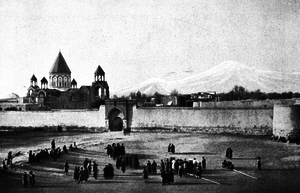
The monastery of Etchmiadzin in the early 20th century with Mount Ararat in the background
In 1903, the Russian government issued an edict to confiscate the properties of the Armenian Church, including the treasures of Etchmiadzin.[2] Russian policemen and soldiers entered and occupied the cathedral.[88][89] Due to popular resistance and the personal defiance of Catholicos Mkrtich Khrimian, the edict was canceled in 1905.[86]
During the Armenian Genocide, the cathedral of Etchmiadzin and its surrounding became a major center for the Turkish Armenian refugees. At the end of 1918, there were about 70,000 refugees in the Etchmiadzin district.[90] A hospital and an orphanage within the cathedral's grounds were established and maintained by the U.S.-based Armenian Near East Relief by 1919.[2]
In the spring of 1918 the cathedral was in danger of an attack by the Turks.[91] Prior to the May 1918 Battle of Sardarabad, which took place just miles away from the cathedral, the civilian and military leadership of Armenia suggested Catholicos Gevorg (George) V to leave for Byurakan for security purposes, but he refused.[92][93] The Armenian forces eventually repelled the Turkish offensive and set the foundation of the First Republic of Armenia.
Soviet suppression
After two years of independence, Armenia was Sovietized in December 1920. During the 1921 February Uprising Etchmiadzin was briefly (until April) taken over by the nationalist Armenian Revolutionary Federation, which had dominated the pre-Soviet Armenian government between 1918 and 1920.[94]
In December 1923, the southern apse of the cathedral collapsed. It was restored under Toros Toramanian's supervision in what was the first case of restoration of an architectural monument in Soviet Armenia.[95]

The Soviet government issued a postage stamp depicting the cathedral in 1978.
During the Great Purge and the radical state atheist policies in the late 1930s, the cathedral was a "besieged institution as the campaign was underway to eradicate religion."[96] The repressions climaxed in 1938 when Catholicos Khoren I was murdered in April by the NKVD.[97] In August of that year, the Armenian Communist Party decided to close down the cathedral, but the central Soviet government seemingly did not approve of such a measure. Isolated from the outside world, the cathedral barely continued to function and its administrators were reduced to some twenty people.[2][98] It was reportedly the only church in Soviet Armenia not to have been seized by the Communist government.[99] The dissident anti-Soviet Armenian diocese in the US wrote that "the great cathedral became a hollow monument."[100]
The religious importance of Etchmiadzin slowly recovered during the Second World War. The Holy See's official magazine resumed publication in 1944, while the seminary was reopened in September 1945.[101] In 1945 Catholicos Gevorg VI was elected after the seven-year vacancy of the position. The number of baptisms conducted at Etchmiadzin rose greatly: from 200 in 1949 to around 1,700 in 1951.[102] Nevertheless, the cathedral's role was downplayed by the Communist official circles. "For them the ecclesiastical Echmiadzin belongs irrevocably to the past, and even if the monastery and the cathedral are occasionally the scene of impressive ceremonies including the election of a new catholicos, this has little importance from the communist point of view," wrote Walter Kolarz in 1961.[103]
Revival
Etchmiadzin revived under Catholicos Vasken I since the period known as the Khrushchev Thaw in the mid-1950s, following Stalin's death. Archaeological excavations were held in 1955–56 and in 1959; the cathedral underwent a major renovation during this period.[7][38] Wealthy diaspora benefactors, such as Calouste Gulbenkian and Alex Manoogian, financially assisted the renovation of the cathedral.[7] Gulbenkian alone provided $400,000.[104]
In 2000[105] Etchmiadzin underwent a renovation prior to the celebrations of the 1700th anniversary of the Christianization of Armenia in 2001.[7] In 2003 the 1700th anniversary of the consecration of the cathedral was celebrated by the Armenian Church.[106] Catholicos Karekin II issued a pontifical encyclical (kondak) on January 30.[107] On February 3 he declared 2003 the Year of Holy Etchmiadzin.[108] In September of that year an academic conference was held at the Pontifical Residence.[109]
The latest renovation of the cathedral began in 2012,[105] with a focus on strengthening and restoring the dome and the roof.[110]
Architecture
Today, Etchmiadzin "has a cruciform plan with a central cupola, four free-standing piers, and four projecting apses which are semicircular on the interior and polygonal on the exterior. The central piers, cruciform in section, divide the interior space into nine equal square compartments."[38]
Exterior design
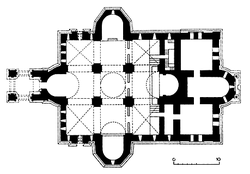
The present-day ground plan of Etchmiadzin
The cathedral's external appearance has been described as "austere",[111] "ascetic",[112] "unostentatious",[113] and as "a massive cube surmounted by a faceted cone on a simple cylinder."[114] Robert H. Hewsen writes that it is "neither the largest nor the most beautiful of Armenian churches", nevertheless, "the overall impression presented by the ensemble is inspiring, and Armenians hold the building in great reverence."[2] James Bryce wrote that the cathedral is "small, that is to say, compared with its fame or importance".[115] Paul Bloomfield, writing for The Times, expressed a similar view: "[the] cathedral, though diminutive by European standards, is immensely important."[116] Herbert Lottman wrote in a 1976 New York Times article: "Like all ancient Armenian churches, the cathedral is characterized by a disarmingly naive, coneshaped steeple. With a minimum of ornament, the building [...] is a solid stone construction, its arches sober romanesque curves."[117]
Alexander Sahinian declared that Etchmiadzin holds a unique position in Armenian (and non-Armenian) architecture history because it reproduces features of different periods of Armenian architecture.[118][119] Despite the fact that the cathedral was renovated many times through the centuries and some alterations were made in the 17th and 19th centuries, it retains the form of the building constructed in 483/4.[2][38][120] The 5th-century building is the core of the cathedral, while the stone cupola, turrets, belfry, and rear extension are all later additions.[2] Engraved on the exterior of the edifice are decorative geometric and floral patterns as well as blind arcades and medallions depicting saints.[38] Portions of the northern and eastern walls of the original building have survived.[56]
  |
  |
Reliefs
- Greek reliefs
The northern wall of the cathedral contains two reliefs which depict Paul the Apostle and Saint Thecla[121] and a cross with all arms of equal length with Greek inscriptions.[38] Paul and Thecla are represented in conversation, Paul is shown seated on cross-legged stool.[122] These reliefs have been dated by various authors between the first and sixth centuries.[123] Shahkhatunian[124] and Ghevont Alishan suggested that these reliefs were created before the invention of the Armenian alphabet in 405.[125] Art historian Sirarpie Der Nersessian believed that they are from the fifth or sixth century.[122] In his 2012 analysis, Grigoryan wrote that "we can insist that the three reliefs of the Echmiadzin Cathedral were created from the very beginning, in 302–325."[123] According to Hasratyan they are the earliest reliefs on the cathedral's walls[60] and among the earliest items of Christian Armenian sculpture art.[56]
Reliefs and ornaments on the western (main) belfry
Relief of a winged creature
Ornaments
A relief depicting the Christ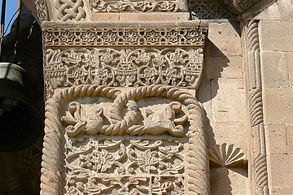
Ornaments
A cross sculpture
Interior design
The early frescoes inside the cathedral were restored in the 18th century. Stepanos Lehatsi (Stephen of Poland) illustrated the belfry in 1664. In the 18th and 19th centuries, Armenian painters created frescoes of scenes from the old testament and Armenian saints.[2] Naghash Hovnatan painted parts of the interior between 1712 and 1721. His paintings on the dome and the painting of the Mother of God under the altar have survived to this day. Other members of the prominent Hovnatanian family (Hakob, Harutyun and Hovnatan) created paintings throughout the 18th century. Their work was continued by the succeeding generations of the same family (Mkrtum and Hakob) in the 19th century.[126]
The wooden doors of the cathedral were carved in Tiflis in 1889.[2] The paintings were moved out of the cathedral by the order of Catholicos Mkrtich Khrimian in 1891 and are now kept in various museums in Armenia, including the National Gallery of Armenia.[38] The frescoes inside the cathedral were restored by Lydia Durnovo in 1956[127] and in 1981–82 under the directorship of Vardges Baghdasaryan.[128]
In the 1950s, the stone floor was replaced with one of marble.[2]
The cupola
Frescoes on the dome
Close up view of the frescoes on the dome
The interior
The altar
Influence
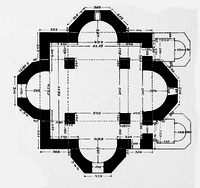
The plan of the Bagaran cathedral

The plan of Germigny-des-Prés
On Armenian architecture
The design of Etchmiadzin Cathedral—classified as "a four-apsed square with ciborium,"[129] and called Էջմիածնատիպ Ejmiatsnatip "Etchmiadzin-type" in Armenian architectural historiography[61]—was not common in Armenia in the early Medieval period. The now-destroyed St. Theodore Church of Bagaran, dating from 624–631,[130] was the only known church with a significantly similar plan and structure from that period.[131][132] In the 19th century, during an architectural revival that looked back to Armenia's past, the plan of Etchmiadzin Cathedral began to be directly copied in new Armenian churches.[133] Some notable examples from this period include the narthex of the St. Thaddeus Monastery in northern Iran, dating from 1811 or 1819–30,[133][134] and the Ghazanchetsots Cathedral in Shusha, dating from 1868.[135][136]
On European architecture
Art historian Josef Strzygowski, who was the first European to thoroughly study Armenian architecture,[137] and who placed Armenia in the center of European architecture,[138] suggested in his 1918 two-volume book titled Die Baukunst der Armenier und Europa (The Architecture of the Armenians and of Europe)[139] that several churches and chapels in Western Europe have been influenced by the cathedrals of Etchmiadzin and Bagaran due to similarities found within their plans.[38] According to Strzygowski, some examples of churches influenced by Etchmiadzin and Bagaran are the 9th-century church of Germigny-des-Prés in France (built by Odo of Metz, probably an Armenian) and San Satiro of Milan, Italy.[N] This view was later supported by Alexander Sahinian and Varazdat Harutyunyan.[38] Sahinian suggested that the Armenian church architecture was spread in Western Europe in the 8th–9th centuries by Paulicians, who migrated from Armenia en mase after being suppressed by the Byzantine government during the Iconoclasm period. Sahinian added many other medieval churches in Europe, such as the Palatine Chapel of Aachen in Germany, to the list of churches to have been influenced by the cathedrals of Etchmiadzin and Bagaran and by Byzantine decorative arts.[61] According to Murad Hasratyan, Etchmiadzin's design was spread to Europe via the Byzantine Empire and served as a model—besides Germigny-des-Prés and San Satiro—for the Nea Ekklesia church in Constantinople and the churches of Mount Athos in Greece.[141]
Significance
"To the Right Hand [of St. Gregory the Illuminator] and to Holy Etchmiadzin, the whole of the Armenian Nation is bound."
—Arakel of Tabriz (17th century)[142]
Etchmiadzin depicted on a 2009 Armenian stamp
For many centuries, Etchmiadzin was the national and political center of the stateless Armenian people. The locus of Etchmiadzin is considered "a sanctified soil" in a way similar to Temple Mount (for Jews) and Harmandir Sahib (for Sikhs).[143] The cathedral complex has been called "Armenian Vatican"[144] or "Armenian Mecca"[145] as it is a major pilgrimage site for religious Armenians worldwide. Because the cathedral has been so important to the development of Armenians' sense of identity, a pilgrimage to Etchmiadzin is "as much as ethnic as a religious experience."[146] American journalist and historian Francis Whiting Halsey described the cathedral as "the most treasured possession of the Armenian nation" and "the source of that strength which has held them together through centuries of persecution, warfare and massacre."[147] Royal Navy Captain James Creagh highlighted its immense role for the Armenian people in his 1880 book, writing that "The monastery and cathedral of Echmiadzin may, without any exaggeration, be described as the heart of the Armenian nation."[148]
Before the foundation of the First Republic of Armenia and the official designation of Yerevan as its capital in 1918, Western sources emphasized Etchmiadzin's political significance. A 1920 book prepared by the Historical Section of the British Foreign Office acknowledged that Etchmiadzin "was regarded as the national capital of the Armenians."[149] "Deprived of a political head and even a political capital the [Armenian] people have, for at least five hundred years, looked to Etchmiadzin as the home of their people, the centre to which they looked for guidance, unfailing sympathy, and practical aid," wrote Welsh journalist and politician W. Llewelyn Williams in his 1916 book about Armenia.[150]
Italian historian and traveler Luigi Villari wrote about the cathedral in 1906:[151]
During every critical phase of their history, the Armenians have looked at Etchmiadzin for guidance, to the Church for close on sixteen hundred years has been their beacon and their hope. A visit to Etchmiadzin enables us to understand the tenacity of this people and their devotion to their faith better than a whole library of books.
Mabel Evelyn Elliott, the Medical Director of Near East Relief, wrote about the cathedral's longevity in 1924:[152]
Changes in temporal affairs have beaten against the walls of Etchmiadzin for sixteen centuries like little waves against a granite cliff. Now the Tsar has fallen, the Soviets have come. The Soviets may endure for a few years or for a few centuries; it is all one to Etchmiadzin. Some day the Soviets will go, as all temporal governments do, but Etchmiadzin will stand.
Notable visitors
Early European visitors to Etchmiadzin who gave descirptions of the cathedral included Jean-Baptiste Tavernier (before 1668),[153] Jean Chardin (1673),[154] Joseph Pitton de Tournefort (c. 1700),[155] James Morier (1810–16),[156] Robert Ker Porter (1817–20),[157] Friedrich Parrot (1829),[158] August von Haxthausen (1843),[159] Moritz Wagner (1843),[160] James Bryce (1876),[161] H. F. B. Lynch (1893).[162]
Many prominent individuals have visited Etchmiadzin, including Russian diplomat and playwright Alexander Griboedov (1828),[163] Russian poet Valery Bryusov,[164] Fridtjof Nansen (1925),[165] English composer Benjamin Britten,[166] Russian singer-songwriter Vladimir Vysotsky,[167] Russian-American poet and essayist Joseph Brodsky[168] and many others visited the cathedral.
In the 21st century major religious figures like Pope John Paul II (2001),[169] Ignatius Zakka I Iwas (2002),[170] Patriarch Kirill of Moscow (2010),[171] Pope Francis (2016) visited Etchmiadzin. Pope Francis gave a prayer at the cathedral on June 24. He called the cathedral "a witness to the history of your people and the centre from which its spirituality radiates."[172]
Presidents of several countries, such as Russia (Vladimir Putin in 2005),[173] France (Jacques Chirac in 2006[174] and Nicholas Sarkozy in 2011),[175] Georgia (Giorgi Margvelashvili in 2014),[176] and royalty, such as Nicholas I of Russia (1837),[177] Prince Charles (2013)[178] have visited the cathedral as part of their state or private visits to Armenia.
Heritage designation
In 2000 UNESCO added Etchmiadzin Cathedral, the churches of St. Hripsime, St. Gayane, Shoghakat and the ruined Zvartnots Cathedral to the list of World Heritage Sites.[179]
In 2002, the cathedral complex with over 50 monuments, including many khachkars (cross-stones) and graves located around the cathedral, was listed by the Government of Armenia in the list of historical and cultural monuments of the Armavir Province.
Relics

The Holy Lance in Echmiadzin
Cultural depictions

50,000-dram banknote
The Etchmiadzin weekly («Էջմիածին» ամսագիր), the official periodical of the Mother See of Holy Etchmiadzin founded in 1944, features the cathedral on its cover page as newspaper logo.[181]
In the 1991 film Mayrig, directed by French-Armenian director Henri Verneuil, actual footage of the cathedral is shown when Azad Zakarian, the main character and a son of Armenian Genocide survivors, is being questioned about his faith in a Catholic school.[182]
The Soviet Union and Armenia issued postage stamps depicting the cathedral in 1978 and 2009, respectively. The cathedral is depicted on the obverse side of 50,000-dram banknote (2001).
Artistic depictions

"View of Ararat and the Monastery of Echmiadzin", from the 1846 English translation of Friedrich Parrot's Journey to Ararat

by Grigory Gagarin, 1847

from John Mason Neale's A History of the Holy Eastern Church (1850)

by August von Haxthausen, 1854

by Robert Sears, 1855
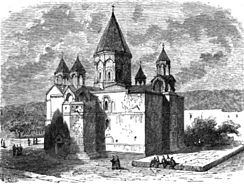
by Floriant Gille, 1859

by Panos Terlemezian, 1903

A relief of Etchmiadzin Cathedral on the headquarters of the Eastern Diocese of the Armenian Church of America next to the St. Vartan Cathedral in Manhattan, New York

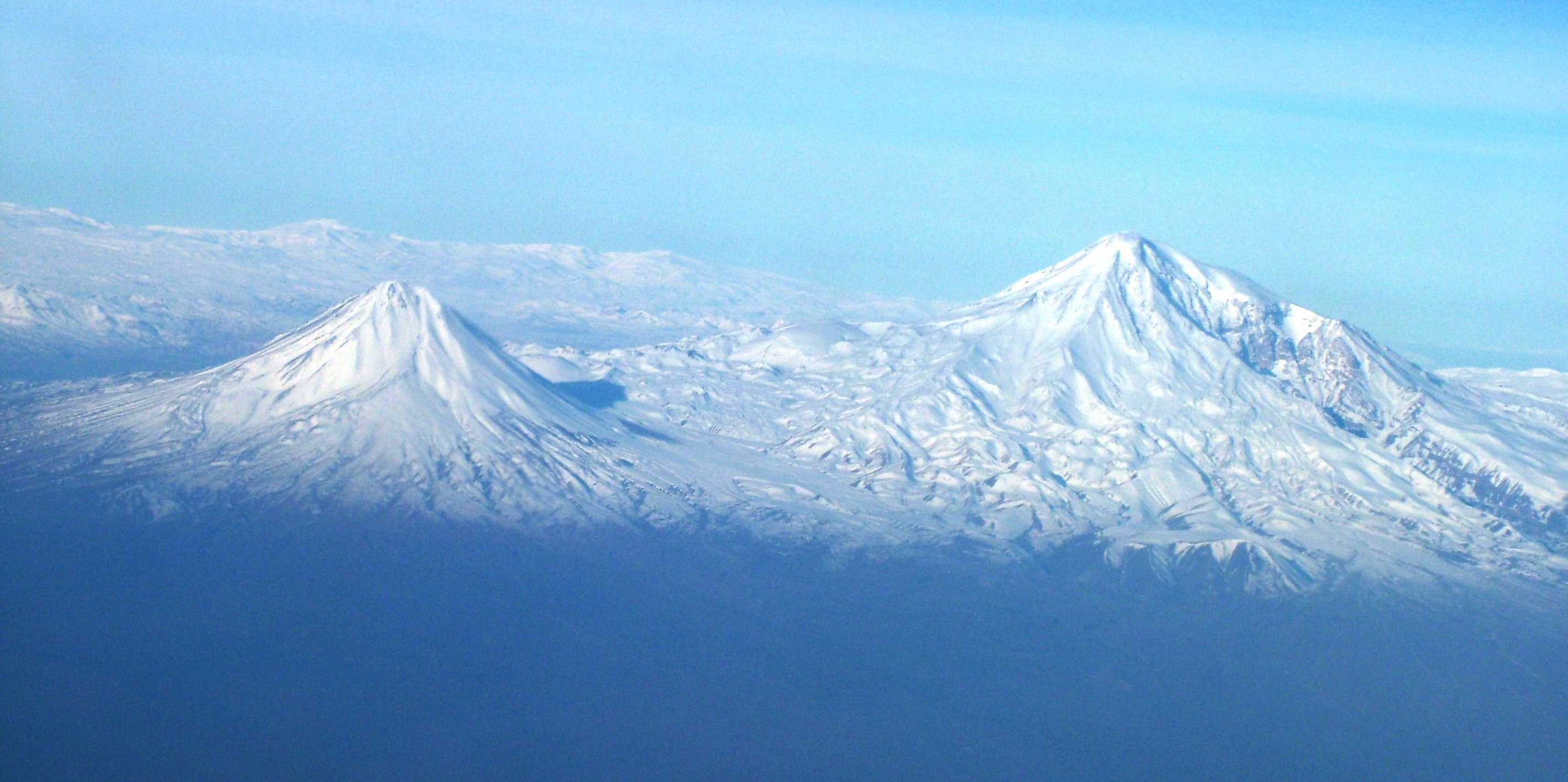

.jpg)
.jpg)
